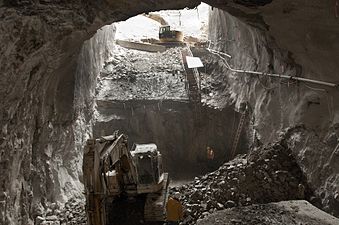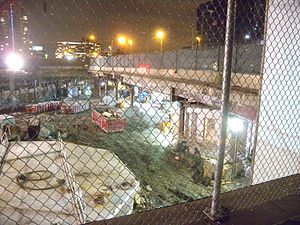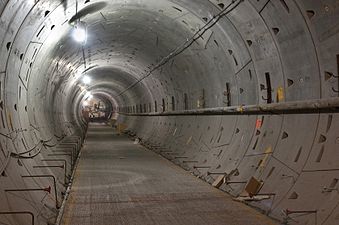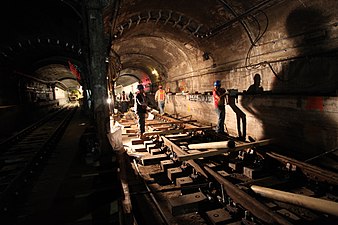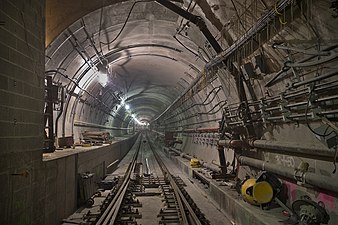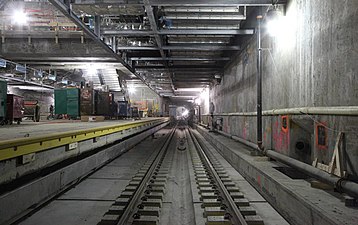7 Subway Extension
| 7 Subway Extension | |
|---|---|
  The 7 and 7 Express (designated as <7> on rolling stock) services serve the entire 7 Subway Extension. | |
| Overview | |
| Owner | City of New York |
| Termini | |
| Stations | 1 constructed (1 proposed) |
| Service | |
| Type | Rapid transit |
| System | New York City Subway |
| Operator(s) | New York City Transit Authority |
| History | |
| Opened | September 13, 2015 |
| Technical | |
| Line length | 1.5 mi (2.4 km) |
| Number of tracks | 2 |
| Character | Underground |
| Track gauge | 4 ft 8+1⁄2 in (1,435 mm) |
| Electrification | 625 V DC third rail |
The 7 Subway Extension is a subway extension of the New York City Subway's IRT Flushing Line, which is served by the 7 local and <7> express services. The extension stretches 1.5 miles (2.4 km) southwest from its previous terminus at Times Square, at Seventh Avenue and 41st Street, to one new station at 34th Street and Eleventh Avenue. A second station at 10th Avenue and 41st Street was dropped from the plans in October 2007. The entirety of the extension is located within the New York City borough of Manhattan. The extension, a key part of the Hudson Yards Redevelopment Project, is expected to bring business and entertainment into the area, as well as aid redevelopment of nearby Chelsea and Hell's Kitchen, located around the Long Island Rail Road's West Side Yard. The extension also serves the nearby Jacob K. Javits Convention Center.
The project was originally proposed in 2005 as part of the Hudson Yards project, which included the failed attempt to build the West Side Stadium for the New York Jets and the city's bid for the 2012 Summer Olympics. Although the stadium plan was rejected by the state legislature, the rest of the Hudson Yards rail yard development, including the 7 Subway Extension, went forward. Construction on the extension started in 2007.
The extension's opening was postponed multiple times from its original target of December 2013. The delays were attributed to a variety of problems, mostly involving the 170-foot-long (52 m) incline elevators that were custom-designed for the new station. The extension finally opened to the public on September 13, 2015.
Historical context
[edit]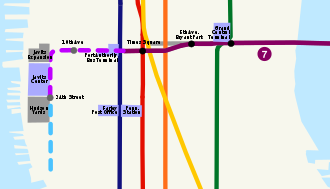
Proposals to extend the transit system to the Far West Side to support massive redevelopment were floated as early as 1969, when the New York City Planning Commission's (CPC's) master plan proposed to expand midtown westward along a 48th Street transit line to replace what the plan described as "blocks of antiquated and deteriorating structures of every sort" between Eighth and Twelfth avenues.[1] That proposal for the West 40s and 50s failed after voters rejected a state bond issue that would have financed the proposed new east–west transit line or "people mover."[2] Subsequently, attention shifted to the West 30s and the IRT Flushing Line.
In response to the CPC's 1993 proposal to improve access to the Manhattan Central Business District,[3] the Metropolitan Transportation Authority (MTA) began exploring the possibility of a 7 extension to New Jersey.[4] In 2001, a business and civic group convened by Senator Charles Schumer argued that a westward extension of the Midtown office district could not be accomplished without a subway extension, saying:[5]
The long blocks along the avenues make the walk as long as 20 minutes to the westernmost parts of the area. In addition, there is no convenient link from Grand Central Station or elsewhere on the east side of Manhattan, making the Far West Side a difficult commute for workers from parts of Manhattan, Queens, Westchester and Connecticut.[5]
An extension of the Flushing Line was then proposed as part of the New York City bid for the 2012 Summer Olympics.[6][7] The City wanted to get funding before July 2005, at which time the International Olympic Committee would vote on funding. However, due to shortfalls in the MTA's Capital Program, as well as preexisting funding for the Second Avenue Subway and East Side Access, the MTA could not pay to fund the extension.[4] After a proposal for the West Side Stadium, an Olympic stadium to be located above the nearby West Side Yard, was rejected in 2005,[8] New York City quickly lost their Olympic bid.[9] However, in a report entitled No. 7 Subway Extension – Hudson Yards Rezoning and Development Program, the government of New York City, devised a rezoning plan for the Hudson Yards area and proposed two new subway stations to serve that area.[10] The subway extension was approved[4] following the successful rezoning of about 60 blocks from 28th to 43rd Streets, which became the Hudson Yards neighborhood.[11]
Mayor Michael Bloomberg's December 12, 2006, address to the New York League of Conservation Voters noted that in November 2006, the government began issuing bonds to fund the extension of the 7 subway to Eleventh Avenue and 34th Street.[12] The $2.4 billion extension was funded with New York City funds from municipal Tax Increment Financing (TIF) bond sales that are expected to be repaid with property tax revenues from future developments in areas served by the extension.[13]
Construction progress
[edit]In October 2007, the Metropolitan Transportation Authority (MTA) awarded a $1.145 billion contract to build 7,000 feet (2,100 m) of twin-tube tunnel from the 7 train's then-terminus at Times Square to the then-planned shell of the 34th Street–Hudson Yards station. The contract was awarded to S3, a joint venture of J.F. Shea, Skanska USA Civil, and Schiavone.[14][15][16] The extension's construction was overseen by the MTA's Capital Construction division.[7] Dattner Architects, designed the 34th Street station.[17] After excavating the new terminal's shell and creating the first 1,000 feet (300 m) of tunnel using the drill-and-blast method, S3 placed two tunnel-boring machines (TBMs) in the ground to dig the remaining 6,000 feet (1,800 m); as it dug, each TBM placed precast concrete liner segments to create the tunnel interior.[17]
Early on in the project, it was announced that the new stations would feature platform screen doors.[18] The stations (along with the new South Ferry station on the IRT Broadway–Seventh Avenue Line and the three Phase 1 Second Avenue Subway stations in the Upper East Side) would include special air-cooling systems to reduce the temperature along platforms.[19] Due to its depth, the extension has ventilation towers, rather than the ventilation grates ubiquitous in the rest of the subway system.[20]
However, in October 2007, soon after the announcement of the new extension, the 10th Avenue station was canceled due to an overrun of the $2.4 billion budget,[14] and the MTA did not have an extra $500 million to build the 10th Avenue station.[21][22] On December 3, 2007, the MTA conducted a ceremony at the Times Square subway station marking the launch of construction of the 7 train extension. The contractor began excavating the station cavern adjacent to the Javits Convention Center.[23] One physical hindrance to the construction of the extension was the lower-level platform at 42nd Street–Port Authority Bus Terminal on the IND Eighth Avenue Line. The abandoned platform was partially razed to allow the 7 train extension to be built.[24] In order for the TBMs to meet up with the existing lay-up tracks west of Times Square, the Eighth Avenue Line had to be underpinned to support the existing line.[25]
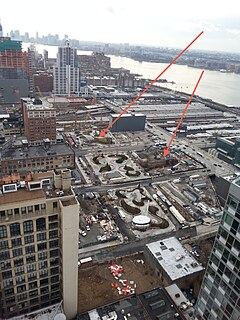
In June 2008, construction on the tunnels began along Eleventh Avenue in Manhattan.[26] In February 2009, S3 lowered the first of two tunnel-boring machines into a giant shaft at the corner of 25th Street and Eleventh Avenue. The two boring machines dug parallel 7,100-foot (2,200 m) long tunnels north along Eleventh Avenue to the current terminus of the 7 service at 41st Street and Times Square.[27] The MTA posted a construction update with photographs on its website in November 2008, showing substantial progress.[28]
The MTA completed excavation of a 150-foot (46 m) long cavern in June 2009. The cavern was dug below the bus entrance ramp to the lower level of the Port Authority Bus Terminal and formed part of the eastern end of the new extension and connected it to the Times Square station. At the same time, tunnels were being dug northward from the machine shaft at 26th Street; soft ground at 27th and 28th Street required 300 feet (91 m) of ground to be frozen so that the tunnel-boring machines could easily dig through the soil.[29] On December 21, 2009, it was announced that a tunnel-boring machine broke through the 34th Street station cavern wall.[29][30] Both tunnel-boring machines were scheduled to finish the required tunneling in the spring of 2010.[31]
In June 2010, one of the TBMs completed its tunnel at the cavern.[32] The second TBM broke through the wall of the cavern on July 15, 2010, completing its tunneling operation.[33] The TBMs were partially disassembled and backed up to the 25th Street shaft, where they were lifted out.[32][33][34] In April 2011, the MTA announced that the contract covering the tunnels, the 34th Street station mezzanine and passenger platform was 85% complete, and that the systems contract, covering mechanical and electrical systems, electric power, lighting and train tracks would be awarded by July 2011. A second entrance to the station is planned.[35] In May 2012, the MTA announced that the extension, now 65% complete, had received the installation of the first set of rails.[36]
On August 21, 2013, the MTA announced that the 7 Subway Extension was 90% complete.[37] On December 20, 2013, Mayor Michael Bloomberg took a ceremonial ride on a train to the new terminal, celebrating a part of his legacy as Mayor; at the time, the proposed opening date was June 2014.[38][39]
Delays
[edit]Soon after Bloomberg's ceremonial ride, the opening date of the subway extension was postponed from June to early fall 2014,[40] then to November 2014,[41] then to February 2015,[42] and then to May 2015.[43] Most of the problems were attributed to the incline elevators being installed in the station,[44] and to the ventilation fans along the tunnel.[42]
On October 1, 2014, the MTA told the New York Daily News that the agency had signed a new agreement with the prime contractor, offering up to $4.75 million in incentive payments if the new station was finished and ready to open to the public by February 24, 2015.[45]
Just two and a half months later, though, the MTA stated that it was unable to open the subway extension for service until April to July 2015, due to the failure to get the inclined elevators to work properly.[43][46] Problems with the security and fire alarm systems were also blamed for the delays.[47] A December 2014 New York Post article attributed the delay to the Hudson Yards rail yard development's developer, The Related Companies', need to dig caissons for the foundations, just above the subway station, and the foundation work needed to be complete before the MTA could open the station.[48] Continuing trouble with the fire and security alarms in March 2015 would delay the opening until summer.[49][50]
The use of inclined elevators was intended to provide wheelchair-using patrons with a shorter, easier path to the train platform, as well as to reduce tunneling costs.[40] The two elevators were manufactured by Maspero Elevatori, in Appiano Gentile, Italy, using a controller made on Long Island, speed governors made in Ohio, and buttons and other parts in Queens.[40] The software for the elevator was written in the United States. Maspero Elevatori assembled the elevators in Italy, and they failed an operational test there, prior to being shipped to the United States.[40] The MTA said the manufacturer chose to use American subcontractors in place of local Italian suppliers after reading the specifications the transit agency submitted. The MTA had been working with the manufacturer to try to resolve the problems caused by a very high level of customization.[40]
On June 1, 2015, a representative for the MTA described the extension as "99% complete". That day, test runs of 7 trains started running to 34th Street–Hudson Yards in preparation for the summer 2015 opening of the extension.[51] However, on June 15, the extension was postponed again to "before the end of the third quarter".[52] On July 20, 2015, it was reported that the MTA planned to open the extension to the public on September 13, 2015.[53][54] The opening date was confirmed on August 28, 2015.[55][56] The station was opened at a ribbon-cutting ceremony on September 13 at about 1 p.m.[57][58][59][60]
Gallery
[edit]-
Digging the station cavern
-
Construction Site P, 11th Avenue and 33rd Street in May 2010
-
Extension work during night time
-
Tunnel under construction as of January 26, 2012[update]
-
Mezzanine and trackways under construction
-
Tunnel portals at end of station cavern
-
Building tracks connecting Times Square to the line extension in March 2012
-
Tunnel progress in September 2012
-
Ventilation structure at 11th Avenue and 36th Street, near construction site K
-
Tunnel on the 7 Subway Extension, under construction
-
Tracks in the station, April 2013
-
Extension, as viewed from Times Square on November 25, 2013. The fake wall has been removed
-
Station entrance under construction in May 2014
-
Rendering of Site A building between 25th and 26th Street, June 2013
Construction areas
[edit]34th Street–Hudson Yards station
[edit]
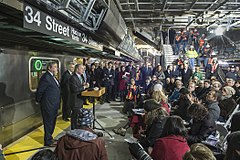
The 34th Street–Hudson Yards station is under the intersection of 11th Avenue and 34th Street. It is the only station on the extension, and it opened on September 13, 2015.[57][58][59] The MTA says that the new station will "make it possible for new housing, restaurants and entertainment to grow" in the surrounding neighborhoods, including Hell's Kitchen and Chelsea.[61] The station is also close to the Jacob K. Javits Convention Center.[62]
Passenger access to the station includes a pair of incline elevators.[44] The project has been plagued by delays because of the mishaps involved in the installation of the custom-made elevators.[63] In June 2012, the extension's opening was delayed to June 2014, with the rest of the 34th Street–Hudson Yards station to open at the end of 2015;[64][65] As of December 15, 2014[update], the opening date was changed to mid-2015.[43][46] In April 2014, the first of the 170-foot-long (52 m) incline elevators was installed in the station.[44] The 80-foot (24 m) high incline elevators[25][66] are the first of their kind in the system.[44] The station is the third station in the New York City Subway to have low vibration tracks installed. These tracks provide a smoother, quieter ride for passengers, and eliminate the need for wooden track blocks.[25]
Above-ground structures
[edit]The extension contains five street-level structures:[67]
- Site A, a ventilation building at 11th Avenue between 25th and 26th Streets[67]
- Site J, a ventilation building at 11th Avenue between 33rd and 34th Streets next to the main entrance and elevator entrance[67]
- Site K, a ventilation building at 11th Avenue between 35th and 37th Streets[67]
- Site L, a ventilation building at 41st Street and Dyer Avenue[67]
- Site P, the secondary station entrance between 11th Avenue between 34th and 35th Streets[67]
Proposals
[edit]
10th Avenue station
[edit]Although a new station at 10th Avenue and 41st Street was part of the original plan, the intermediate station was eliminated in October 2007 due to cost overruns, leaving the terminal station at Eleventh Avenue and 34th Street as the only new station on the extension. The MTA indicated that the 10th Avenue station could be included in the project if funding were found.[14] The station was not included in the original (2007) contract award, but was listed as a $450 million option. In late December 2007, reports indicated that the postponed station might be partially built if the City of New York and the MTA agreed on the additional financing for the station shell.[68] In February 2009, the MTA announced that it would build the station if the agency received sufficient funds from the federal economic stimulus package.[69] In June 2010, the city announced it was seeking funding to assess the feasibility of constructing the station at a later date using a two-platform, two-entrance model without an underground connecting passage.[70][71][72][73][74]
Construction of the line proceeded to its completion in 2014 without the station or its shell.[75][76] In January 2016, the New York City Economic Development Corporation released a request for proposal (RFP) for a site of a proposed development at 41st Street and Tenth Avenue,[77][78] including a study into the 10th Avenue station's feasibility.[79] The new station was projected to cost $1 billion at the time.[80] New York City Council candidate Erik Bottcher proposed completing the station in mid-2021,[81] and elected officials again pushed for the station's construction in August 2022.[82][83] By 2023, the MTA predicted that the station could cost $1.9 billion.[84]
Extensions to New Jersey
[edit]In 2010, The New York Times reported that Mayor Michael Bloomberg's administration had been considering an extension to Hoboken and to Secaucus Junction in New Jersey, allowing commuters from that state to more easily access Grand Central Terminal and other subway routes.[85] If opened, the extension would take the New York City Subway outside the borders of both New York City and New York state for the first time.[86] The planned extension would have cost less than the canceled Access to the Region's Core project, but travel times would be longer than the ARC project.[87] The project, which could require five additional years to develop, would not be automatically entitled to the federal funding allotted to the ARC tunnel.[88][89][90]
On February 2, 2011, the city's Economic Development Corporation voted to budget up to $250,000 for a feasibility study of the proposed New Jersey extension, carried out by engineering firm Parsons Brinckerhoff.[91][92] Amtrak's February 2011 announcement of the Gateway Project, which entailed two new commuter rail tunnels under the Hudson River, included a proposal to extend the 7 service three blocks east of Eleventh Avenue to New York Penn Station, instead of five miles west to Secaucus.[93] Congress allocated $15 million for studies for the project in November 2011, with the likelihood that Gateway and the subway extension would be in competition for funding.[94] In April 2012, citing budget considerations, the director of the MTA, Joe Lhota, said that it was doubtful the extension would be built in the foreseeable future.[95] After the Parsons Brinckerhoff feasibility study was released in April 2013,[96][97] Bloomberg said: "Extending the 7 train to Secaucus is a promising potential solution ... and is deserving of serious consideration."[96][98] In November 2013, the New Jersey Assembly passed Resolution 168[99] supporting the extension of the line to Hoboken and Secaucus.[100]
In 2017, a further extension of the 7 train to New Jersey was suggested once again, this time as an alternative to constructing a replacement for the Port Authority Bus Terminal.[101] An alternative would include a new terminal at Secaucus Junction in connection with the 7 extension.[102] In February 2018, it was revealed that the Port Authority had advertised for consultants to write an 18-month feasibility study for such an extension, and that it had received bids from several companies. This extension was being planned along with the Gateway Project and, if built, would be able to accommodate a projected 38% increase in the number of people commuting between the two states.[103][104] If the New Jersey subway extension were constructed, it could complement the Gateway Project, which was predicted to become overcrowded by 2040.[104][105] At the time, the Port Authority was upgrading the PATH system, the only rapid transit link between New York and New Jersey, to accommodate more frequent trains.[104]
Extension to 14th Street
[edit]The Regional Plan Association, in its Fourth Plan in 2017, proposed extending the 7 subway down the tail tracks and the Hudson waterfront to a new station at 14th Street and Tenth Avenue, with an intermediate stop at 23rd Street and Eleventh Avenue. If constructed, the new Tenth Avenue station would feature a pedestrian connection to the 14th Street/Eighth Avenue station, with transfers to the A, C, E, and L trains, and the tunnel would be configured to allow for a New Jersey extension.[106]
Awards and innovations
[edit]The New York State Society of Professional Engineers awarded the first construction phase, "Running Tunnels and Underground Structures," its 2013 Construction Project of the Year. According to the society, the project team won the award "for outstanding professional engineering efforts in developing creative solutions and innovative technologies in construction of an infrastructure project. The No. 7 project used the first double-shielded tunnel boring machines (TBMs) to tunnel under New York City while placing precast concrete segments to form the tunnels' walls. For the first time in the world, a ground freezing method was used to harden soil to act as rock to allow TBMs to maintain proper course while boring and placing the tunnel liners."[107] While the extension extends 1 mile (1.6 km), the tunnels are actually 1.5 miles (2.4 km) long.[108]
See also
[edit]- East Side Access (LIRR)
- Gateway Project (Amtrak)
- Lower Manhattan–Jamaica/JFK Transportation Project (AirTrain JFK/LIRR)
- Second Avenue Subway – Another expansion of the New York City Subway system
References
[edit]- ^ Stern, Michael (December 8, 1970). "6TH AND LAST PART OF MASTER PLAN ON CITY RELEASED; Volume on Manhattan Urges Building of Offices Along 48th St. Transit Line WESTWARD PATTERN SET Condemnation of Big Tracts Intended to Insure Public Use of Some of Area". The New York Times. Retrieved September 20, 2015.
- ^ Witkin, Richard (November 4, 1971). "State Will Cancel Some Road Projects". The New York Times.
- ^ Department of City Planning, "Shaping the City's Future," 1993.
- ^ a b c Moss, Mitchell L. (November 2011). "HOW NEW YORK CITY WON THE OLYMPICS" (PDF). Rudin Center for Transportation Policy and Management, Robert F. Wagner Graduate School of Public Service. New York University. Retrieved September 11, 2015.
- ^ a b Preparing for the Future: A Commercial Development Strategy for New York City : Final Report. Group of 35. 2001. p. 56. Retrieved September 12, 2015.
- ^ "No. 7 Subway Extension". Hudson Yards Development Corporation. Archived from the original on February 9, 2015. Retrieved July 3, 2013.
- ^ a b Dobnik, Verena (February 7, 2013). "NYC Transit Projects: East Side Access, Second Avenue Subway, and 7 Train Extension". Huffington Post. Retrieved July 24, 2013.
- ^ Bagli, Charles V.; Cooper, Michael (June 7, 2005). "Olympic Bid Hurt as New York Fails in West Side Stadium Quest". The New York Times. Retrieved September 12, 2015.
- ^ Bernstein, Andrea (July 6, 2005). "New York Comes in a Disappointing Fourth Place". WNYC. Retrieved September 12, 2015.
- ^ "NO. 7 SUBWAY EXTENSION-HUDSON YARDS REZONING AND DEVELOPMENT PROGRAM" (PDF). nyc.gov. Archived from the original (PDF) on March 4, 2016. Retrieved September 26, 2015.
- ^ Purnick, Joyce (January 2, 2005). "What Rises in the West? Uncertainty". The New York Times. Retrieved March 6, 2010.
- ^ Hinderer, Katie (December 13, 2006). "NYC Mayor Outlines Long-Term Growth Plan". GlobeSt.com. Archived from the original on May 13, 2009. Retrieved February 28, 2010.
- ^ "City Raises $2 Billion In Bonds For No. 7 Line Extension". NY1. December 7, 2006. Archived from the original on October 11, 2007. Retrieved February 28, 2010.
- ^ a b c "Transit Board Approves Funding For 7 Line Extension". NY1. October 25, 2007. Archived from the original on March 25, 2008. Retrieved February 28, 2010.
- ^ "Top New York Projects" (PDF). New York Construction. June 2008. p. 27. Archived from the original (PDF) on July 8, 2011. Retrieved February 28, 2010.
- ^ "Mayor Bloomberg and Governor Spitzer Announce Start of Construction on #7 Subway Extension" (Press release). New York City Mayor's Office. December 3, 2007. Retrieved February 28, 2010.
- ^ a b "No. 7 Subway Line Extension". Dattner Architects. Archived from the original on March 15, 2012. Retrieved February 28, 2010.
- ^ "MTA Plans To Install Platform Doors On 7 Line Extension". NY1. September 8, 2007. Archived from the original on March 25, 2008. Retrieved February 28, 2010.
- ^ Donohue, Pete (August 4, 2006). "Cooler Subways Coming – Eventually". Daily News. New York. Archived from the original on December 27, 2016. Retrieved February 28, 2010.
- ^ Roberts, Sam (September 30, 2013). "No Heel Hazards (or Gusts) as Subway Expands". New York Times. New York. Retrieved May 5, 2014.
- ^ Neuman, William (October 20, 2007). "Higher Costs Force Cutback in Extension of the No. 7 Line". The New York Times. Retrieved September 28, 2015.
- ^ Olshan, Jeremy (October 21, 2007). "MTA: IT'S WESTWARD HO(LD ON A $EC) FOR NO. 7 TRAIN". Internet Archive. Archived from the original on October 21, 2007.
- ^ "MTA starts work on No. 7 train extension". AM New York. December 14, 2007. Archived from the original on December 14, 2007.
- ^ Mindlin, Alex (April 20, 2008). "No Whoosh, No 'All Aboard'". The New York Times. Retrieved February 28, 2010.
- ^ a b c "mta.info | Capital Programs 7 Line Extension". web.mta.info. Retrieved August 30, 2016.
- ^ "Easy-to-Install CertainTeed Certa-Lok Yelomine Offers Ideal Solution for Temporary Water Lines for Metropolitan Transportation Authority's No. 7 Subway Extension" (Press release). CertainTeed. January 25, 2011.
- ^ "Metropolitan Transportation Authority And Mayor Bloomberg Preside Over Lowering Of Tunnel Boring Machine For 7 Line Subway Extension" (Press release). Metropolitan Transportation Authority. February 19, 2009. Archived from the original on December 18, 2010. Retrieved February 28, 2010.
- ^ "Construction Update — November 2008". Metropolitan Transportation Authority. Archived from the original on October 5, 2009. Retrieved August 27, 2009.
- ^ a b "Mayor Bloomberg And Mta Announce Completion Of First Phase Of Number 7 Subway Extension". NYC.gov. December 21, 2009. Archived from the original on June 20, 2015. Retrieved June 9, 2014.
- ^ "West Side Development Project Gets The Green Light". NY1. December 21, 2009. Archived from the original on April 7, 2012. Retrieved February 28, 2010.
- ^ Cuza, Bobby (February 19, 2009). "Crews Lower Giant Drill Into 7 Line Tunnel". NY1. Archived from the original on May 5, 2009. Retrieved February 28, 2010.
- ^ a b "New Milestone for No. 7 Subway Extension Project". Metropolitan Transportation Authority. June 11, 2010. Archived from the original on June 13, 2010. Retrieved June 12, 2010.
- ^ a b "New Milestone for No. 7 Subway Extension Project". Metropolitan Transportation Authority. July 15, 2010. Archived from the original on July 24, 2010. Retrieved July 16, 2010.
- ^ "7 Train Extension Celebrates Major Breakthrough". NY1. July 15, 2010. Archived from the original on September 29, 2012. Retrieved July 16, 2010.
- ^ "Work on Extending the No. 7 Line Continues to Progress". MTA. April 4, 2011. Archived from the original on August 20, 2011. Retrieved April 4, 2011.
- ^ Miller, Luther S. (May 10, 2012). "NYCT's No. 7 extension gets first rails". Railway Age. Archived from the original on May 13, 2012. Retrieved May 14, 2012.
- ^ "7 Line Extension 90 Percent Complete". MTA Press Release. Archived from the original on July 2, 2018. Retrieved August 22, 2013.
- ^ "Three cheers for the No. 7 extension". New York Post. December 20, 2013.
- ^ Fermino, Jennifer (October 21, 2013). "Mayor Bloomberg gets ride on No. 7 subway line extension he championed". NY Daily News. New York. Archived from the original on December 22, 2013. Retrieved December 22, 2013.
- ^ a b c d e Flegenheimer, Matt (January 27, 2014). "More Delays and Rising Cost for Project Connecting L.I.R.R. to Grand Central Terminal". New York Times.
- ^ Lynch, Marley (February 26, 2014). "Subway update: 7-train extension to now open in November". Time Out New York. Archived from the original on March 6, 2016. Retrieved September 13, 2015.
- ^ a b Mueller, Benjamin (June 23, 2014). "Transit Hub and Work on No. 7 Line Face Delays". New York Times.
- ^ a b c Donohue, Pete (December 15, 2014). "New York will have to wait till spring for No. 7 subway extension". NY Daily News. Retrieved December 15, 2014.
- ^ a b c d Donohue, Pete (April 28, 2014). "Metropolitan Transportation Authority building New York City subway system's first inclined elevator". New York Daily News. Retrieved April 29, 2014.
- ^ Donohue, Pete (October 1, 2014). "No. 7 subway line extension to West Side on track to open in February: official". New York Daily News. Archived from the original on October 1, 2014.
- ^ a b Sill, Andrew (December 15, 2014). "Hudson Yards subway extension delayed again". NBC New York.
- ^ Goldberg, Barbara (December 21, 2014). "NYC subway extension may transform Manhattan neighborhood". McCall.com. Archived from the original on December 30, 2014. Retrieved December 30, 2014.
- ^ Harshbarger, Rebecca (December 15, 2014). "7 train opening delayed". New York Post.
- ^ "7 subway line extension delayed yet again, eyes summer opening". New York Business Journal. March 24, 2015.
- ^ Fitzsimmons, Emma G. (March 24, 2015). "More Delays for No. 7 Subway Line Extension". The New York Times. Retrieved March 29, 2015.
- ^ "MTA Begins Training Employees On No. 7 Line Extension". CBS News. June 1, 2015. Retrieved June 1, 2015.
- ^ Martinez, Jose (June 15, 2015). "MTA: 7 Line Extension to Open Up Before End of Third Quarter". NY1. Retrieved June 20, 2015.
- ^ Whitford, Emma (July 20, 2015). "7 Line Extension Will Open "By September 13th"". Gothamist. Archived from the original on July 22, 2015.
- ^ Siff, Andrew (July 2015). "Hudson Yards Subway Extension to Open in September: MTA". NBC New York.
- ^ Tangel, Andrew (August 28, 2015). "At Last: New Station for 7 Train Set to Open". WSJ. Retrieved September 10, 2015.
- ^ Newman, Philip (September 10, 2015). "No. 7 station to open at last on 11th Ave. in Manhattan". TimesLedger. Archived from the original on September 25, 2015. Retrieved September 10, 2015.
- ^ a b Fitzsimmons, Emma G. (September 10, 2015). "Subway Station for 7 Line Opens on Far West Side". The New York Times. Retrieved September 13, 2015.
- ^ a b "New 7 line subway extension to the West Side opens". ABC7 New York. September 13, 2015. Retrieved September 13, 2015.
- ^ a b Tangel, Andrew (September 13, 2015). "New Subway Station Opens on NYC's Far West Side". WSJ. Retrieved September 13, 2015.
- ^ "New 34 St-Hudson Yards 7 Station Opens". Building for the Future. New York, New York: Metropolitan Transit Authority. Archived from the original on March 4, 2016. Retrieved March 10, 2016.
The new station opened September 13, 2015
- ^ Staff writer(s). "7 Line Extension". Metropolitan Transportation Authority. Retrieved July 3, 2013.
- ^ Green, Dennis (April 29, 2015). "A series of delays have kept a now fully completed subway station under Manhattan from opening". Business Insider. Retrieved September 13, 2015.
The troubled extension ... will eventually extend the 7 train one station west to serve a new development over the West Side Yard train tracks (known as Hudson Yards) and finally provide a rail link to the Jacob Javits Convention Center.
- ^ Flegenheimer, Matt (May 29, 2014). "With New Slant on Subway Elevators, Expect Delays". The New York Times. Retrieved May 29, 2014.
- ^ "MTA's 7 Line Extension Project Pushed Back Six Months". NY1. June 5, 2012. Archived from the original on July 11, 2012. Retrieved June 5, 2012.
- ^ Cuozzo, Steve (June 5, 2012). "No. 7 train 6 mos. late". New York Post. Retrieved June 5, 2012.
- ^ Flegenheimer, Matt (December 20, 2013). "For a Mayor on His Way Out, a Subway Station on Its Way In". The New York Times. Retrieved December 24, 2013.
- ^ a b c d e f "Capital Program 7 Line Extension". MTA.info. December 20, 2013. Retrieved January 30, 2014.
- ^ Naanes, Marlene (December 20, 2007). "7 Line Extension May Get 41st Street Stop". amNewYork. Archived from the original on May 13, 2009. Retrieved February 28, 2010.
- ^ Kabak, Benjamin (February 2, 2009). "Will the Stimulus Save 7 Extension Stop?". Second Ave. Sagas. Retrieved February 28, 2010.
- ^ Agovino, Theresa (February 16, 2010). "Outcry Emerges for 41st St. Stop on New 7-Line". Crain's New York Business. Archived from the original on February 18, 2010. Retrieved April 3, 2010.
- ^ Urban, Jill (April 2, 2010). "West Side Developers Fight For 7 Line Extension". NY1. Archived from the original on April 17, 2010. Retrieved April 3, 2010.
- ^ "City Officials Seek Federal Assistance For 7 Subway Extension". NY1. April 27, 2010. Archived from the original on May 31, 2010. Retrieved April 27, 2010.
- ^ "City Considering 10th Avenue Stop For 7 Train". NY1. June 10, 2010. Archived from the original on September 27, 2012. Retrieved June 10, 2010.
- ^ "Mayor Applies For Funds To Redesign 7 Train Extension". NY1. June 30, 2010. Archived from the original on July 14, 2011. Retrieved June 30, 2010.
- ^ MTA.info—Video Release: Mayor Bloomberg Rides First 7 Train to 34 St - 12/20/2013 on YouTube. Retrieved May 27, 2014. (The tunnel wall flattens out between approximately 2:58 and 3:11 into the video.)
- ^ Video inside the 7 extension Second Avenue Sagas.com
- ^ Rajamani, Maya (April 4, 2016). "MTA Revives Plans for 10th Avenue Station on 7 Line". DNAinfo New York. Archived from the original on November 10, 2017. Retrieved June 8, 2021.
- ^ Plitt, Amy (January 27, 2016). "City Seeking Proposals For Huge Midtown West Mixed-Use Site". Curbed NY. Retrieved January 29, 2016.
- ^ "HELL'S KITCHEN AT TENTH" (PDF). Archived from the original (PDF) on February 2, 2016. Retrieved January 29, 2016.
- ^ Plitt, Amy (April 4, 2016). "MTA May Be Reconsidering a 7 Line Station at Tenth Avenue". Curbed NY. Retrieved April 4, 2016.
- ^ Garber, Nick (June 7, 2021). "Hells Kitchen Candidate Wants To Revive Proposed 7 Train Station". Midtown-Hell's Kitchen, NY Patch. Retrieved June 8, 2021.
- ^ Duggan, Kevin (August 10, 2022). "Manhattan pols revive push for 10th Avenue station on No. 7 train in Hell's Kitchen". amNewYork. Retrieved October 6, 2023.
- ^ Rahmanan, Anna (August 10, 2022). "Could Hell's Kitchen finally get a new subway station? Officials are pushing for it". Time Out New York. Retrieved October 6, 2023.
- ^ Kaske, Michelle (October 4, 2023). "MTA Unveils a Plan to Fix NYC's Aging Transit System". Bloomberg.com. Retrieved October 6, 2023.
- ^ Bagli, Charles V. (November 17, 2010). "Take the No. 7 to Secaucus?". The New York Times. Retrieved July 3, 2013.
- ^ Bagli, Charles V. (November 16, 2010). "New York Studies Extending Subway Line to New Jersey". The New York Times. Archived from the original on November 18, 2010. Retrieved November 16, 2010.
- ^ Bernstein, Andrea (November 16, 2010). "Mayor Bloomberg Explores Extending Subway to New Jersey". WNYC. Archived from the original on November 20, 2010.
- ^ "NJ Commuters Like 7 Train Extension Plan". WCBS. November 17, 2010.
- ^ "Tunnel to Nowhere Might Become 7 to Secaucus". WNBC. November 17, 2010.
- ^ Roth, Jaime (November 17, 2010). "7 Subway Extension to NJ (Video)". WABC. Archived from the original on June 29, 2011. Retrieved November 18, 2010.
- ^ Bernstein, Andrea (February 4, 2011). "City finally puts $ behind subway to New Jersey". Transportation Nation. Archived from the original on February 6, 2011. Retrieved February 7, 2011.
- ^ New York City Economic Development Commission (February 2, 2011). "No. 7 Line Extension to Secaucus Consultant Services" (PDF). www.scribd.com. Retrieved February 7, 2011.
- ^ "Gateway Project" (PDF). Amtrak. February 2011. p. 7. Archived from the original (PDF) on February 7, 2011. Retrieved February 7, 2011.
- ^ Higgss, Larry (December 4, 2011). "Tunnelvision Gateway project, No. 7 train extension latest to vie for trans-Hudson blessing". Asbury Park Press. Retrieved December 5, 2011.
- ^ Haughney, Christine (April 3, 2012). "MTA Chief rules out subway line to New Jersey". The New York Times. Retrieved April 4, 2012.
- ^ a b Frassinelli, Mike (April 10, 2013). "Plan to extend No. 7 subway from NYC to New Jersey could be back on track". The Star-Ledger. Retrieved April 10, 2013.
- ^ Rouse, Karen (April 10, 2013). "Report: Extending NY No. 7 subway line to Secaucus would accommodate commuter demand". The Record. Archived from the original on April 13, 2013. Retrieved April 10, 2013.
- ^ Parsons Brinckerhoff (April 2013). No 7 Secaucus Extension Feasibility Analysis Final Report (PDF) (Report). NYCEDC. p. III–X. Archived from the original (PDF) on November 5, 2013. Retrieved April 10, 2013.
- ^ "AN ASSEMBLY RESOLUTION supporting the extension of the New York City IRT Flushing Line into the State of New Jersey" (PDF). ASSEMBLY RESOLUTION No. 168 STATE OF NEW JERSEY 215th LEGISLATURE. New Jersey Legislature. May 13, 2013. Archived from the original (PDF) on September 19, 2020. Retrieved November 26, 2013.
- ^ Brenzel, Kathryn (November 26, 2013). "Committee green lights expansion of NYC subway to Hoboken". NJ.com. Retrieved November 26, 2013.
- ^ Higgs, Larry (April 21, 2017). "New York subway extension to N.J. may not be dead after all". NJ.com. Retrieved February 28, 2018.
- ^ Smith, Sandy (April 26, 2017). "On-Again, Off-Again New Jersey Bus Terminal May Be On Again". Next City. Retrieved May 5, 2017.
- ^ Barone, Vincent (February 27, 2018). "Cross-Hudson study options include 7 line extension into NJ". am New York. Retrieved February 28, 2018.
- ^ a b c McGeehan, Patrick (February 27, 2018). "A Subway Ride to New Jersey? It Could Happen, Officials Say". The New York Times. ISSN 0362-4331. Retrieved February 28, 2018.
- ^ Rivoli, Dan (February 13, 2018). "Transit study will look into running No. 7 train into New Jersey". NY Daily News. Retrieved February 28, 2018.
- ^ "Fourth Regional Plan - Regional Plan Association". Regional Plan Association. November 2017. Retrieved January 22, 2022.
- ^ "New York State Society of Professional Engineers Recognizes No. 7 Line Project". Tunnel Business Magazine. July 3, 2013. Retrieved August 20, 2013.
- ^ "7 Line Extension". MTA.info. Retrieved November 10, 2013.
External links
[edit]| External videos | |
|---|---|
| YouTube video clips about the 7 Subway Extension by Metropolitan Transportation Authority | |
 | |
 Media related to 7 Subway Extension at Wikimedia Commons
Media related to 7 Subway Extension at Wikimedia Commons- 7 Subway Extension Update – Official MTA 7 Subway Extension Project Page (updated November 2008 and October 2009)
- New Milestone for No. 7 Subway Extension Project – MTA.info Website (June 11, 2010).
- Work on Extending the No. 7 Line Continues to Progress Archived April 13, 2014, at the Wayback Machine – MTA.info Website (April 4, 2011).
- 7 Extension Progress April 2011 (5 photos) – MTA's Facebook Website
- 7 Extension Progress June 14, 2011 (29 photos) – MTA's Facebook Website
- 7 Extension Update – January 26, 2012 (27 photos) – MTA's Facebook Website
- Subway to Secaucus – Our Proposal original proposal for New Jersey extension

